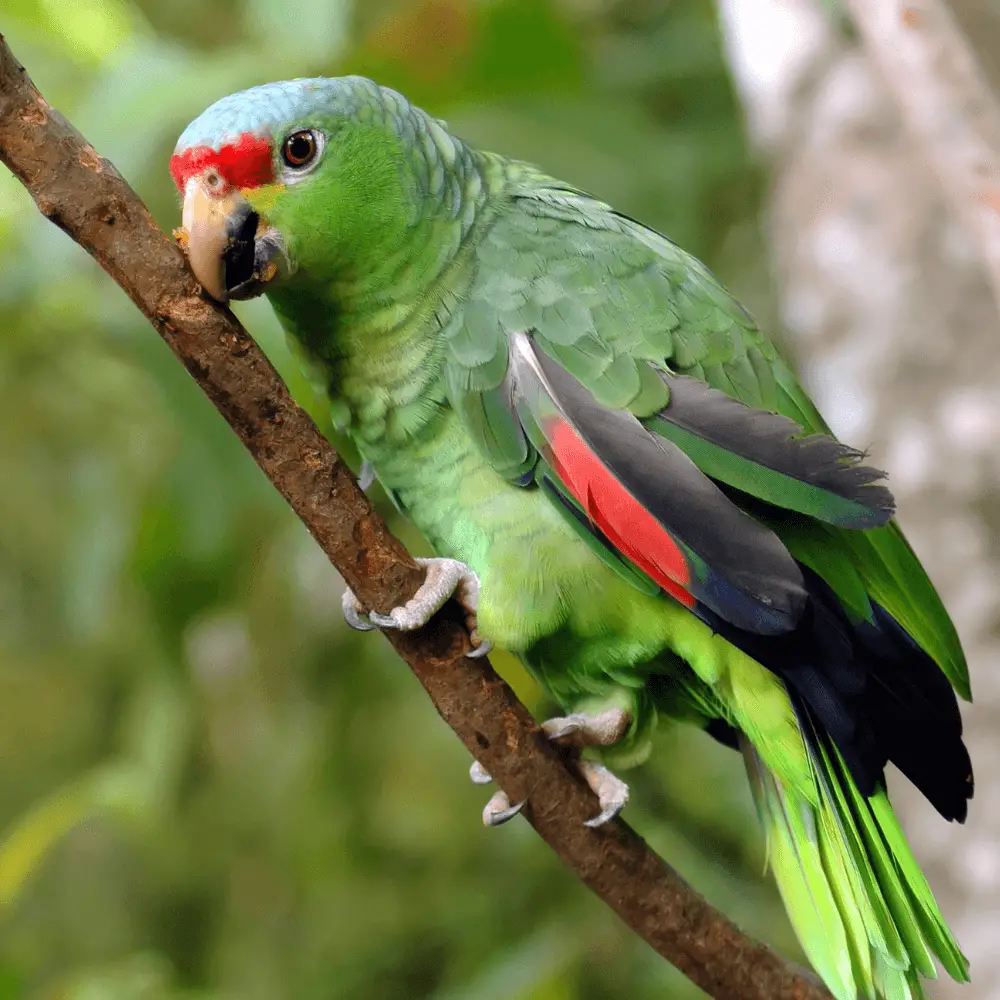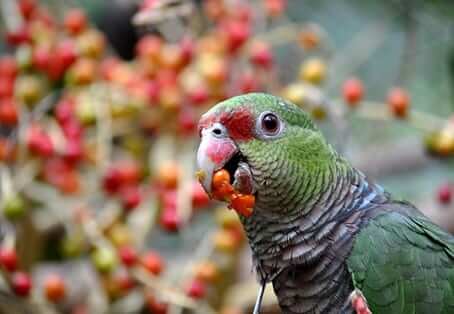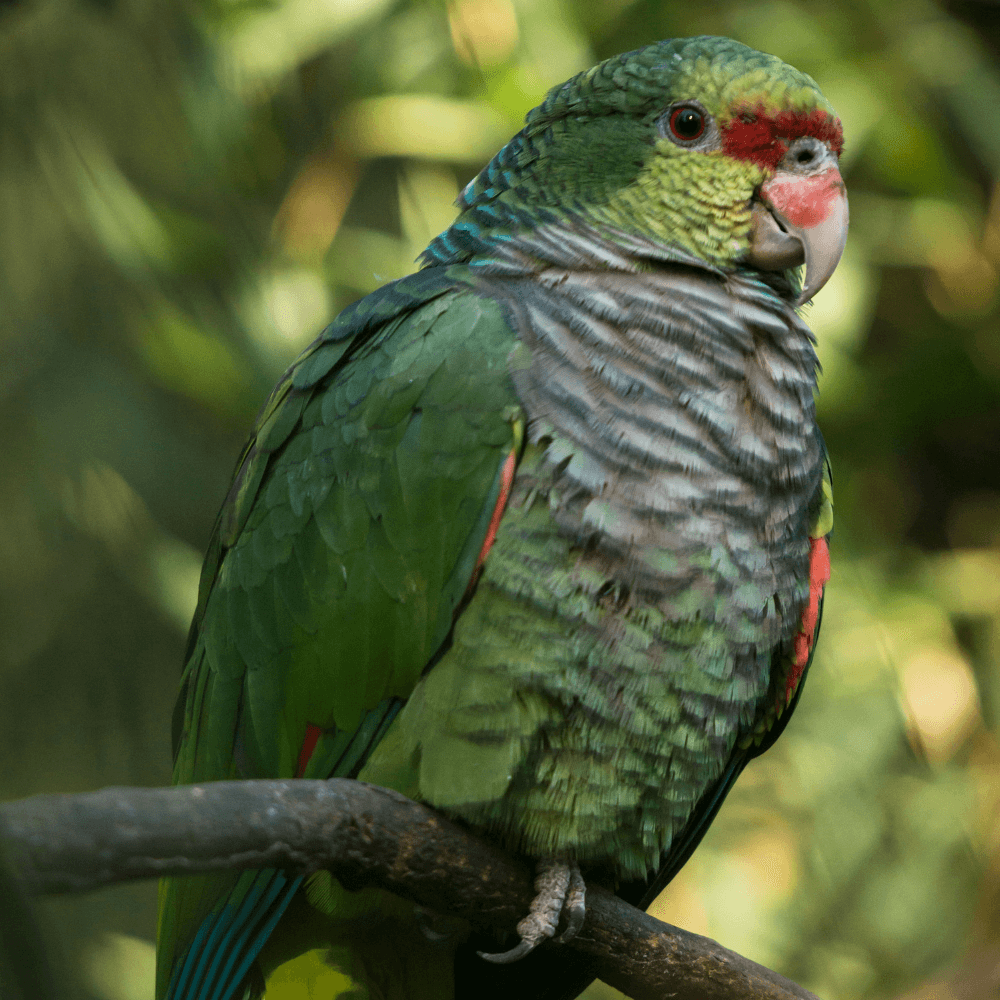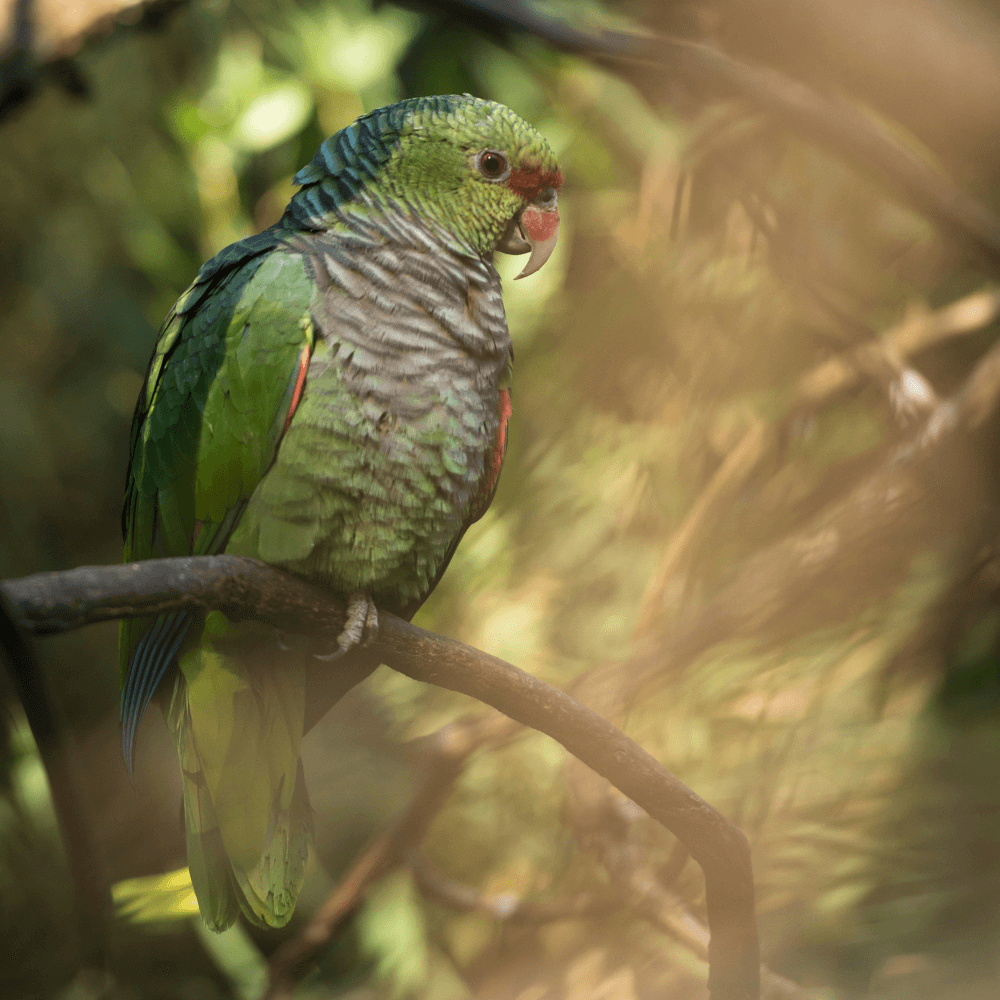
For a long time, the author, Lars Lepperhoff has been interested in Vinaceous Amazons; he has had this Amazon reproduced regularly, both by parents and with the help of hand breeding. The dream of one day being able to observe Vinaceous-breasted Amazons in the wild has come true. The editor of the Swiss bird association EXOTIS, which publishes the magazine “Geflederter freunds”, left under the Argentine sun.
It must be said in passing that the Vinaceous amazon has been difficult to survive for quite some time because of the lack of araucaria forests, the typical coastal forests north of Argentina and Brazil to the Atlantic Ocean.
The theme of the Vinaceous amazon has 3 parts. The first contains the author’s observations of nature. The second part will talk about breeding and housing in poultry farming. In the third part, we will visit 3 young women in Brazil who are committed to making wild, especially the Vinaceous-breasted amazons that have been confiscated.
Landing except. From the beginning, I was already skeptical about the new information in the specialized literature about life in the wild of Vinaceous Amazons. (Amazona vinacea). Most of the information came from Brazil. In Argentina lives a remaining population, it was reported or it is very rarely seen in Argentina. Sometimes I heard stories that the population of Vinaceous-breasted Amazons would be totally extinct in Argentina.
In the meantime, I landed safely at Iguacu Airport. The conversation in the car that took me from the airport to San Pedro, was very interesting. The driver, Patricio Ramirez, proved to be a highly experienced and competent ornithologist. He was my guide and I thought I could count on this man for a little while. “We’ll see the birds,” he said cautiously with a rather mischievous chuckle.
The car rode zigzag between trucks and motorcycles along rows of houses where there seemed to be no end. I was wondering if there were no traffic rules here. Patricio told me that Eldorado is the longest village in the world as he kept an eye on the scenes that took place outside and slipped next to the window. After about fifteen kilometers the rows of houses decreased. It started to get dark and rain.
Raindrops erupted on the windshield of the car and trucks in the opposite direction blinding enormously. What had gone through my head? I was really not comfortable but I still arrived in the early evening at my hotel which was a block away on the outskirts of San Pedro.
A small room that looked like a dungeon, that’s where I was going to spend the night. The window was very small and placed very high. Patricio had small red eyes and yawned. see you tomorrow at, and he disappeared. I closed the rickety, creaky door.
I could not imagine that we could observe wine amazons here. I no longer had any confidence in this whole story, but thinking about all this would be for later because I was overcome by fatigue and fell into a deep sleep.

In the kingdom of Araucaria. The next day, we were already on the march while it was still dark. After a few minutes, we were already in the Selva Misionera, the typical forest of this region. Around 5:30 a.m. begins the dawn and the strange treetops, specific to the araucaria or Brazilian fir (aracaria augustifolia) were drawn in the lead-colored sky.
Around 6 a.m. the first dark yellow rays of the sun shone from the east above the forest. The araucaria, peculiar and primitive shows a completely different image than for example a virgin forest always wet and green with flowers, berries, and colorful birds.
The araucaria trees were already on the earth when dinosaurs walked there. When we look at the landscape here with a little fantasy, we find ourselves in the middle of the Dino period. I noticed an old wooden table with the inscription “San Pedro National Park” that was established in 1991.
We were in the protected araucaria forest of the San Pedro department in the Misiones province. Suddenly a cry echoes through the forest, and a “creo, creo, creo” sound is emitted from afar. I stopped sharp and stiffly but Patricio was smiling and nodding. The Amazons Parrot are here and we can already hear them from far away, he told me. We continued again in the forest and came across an open and steep place. Patricio tells me: “The araucaria plays a very important role in the life of the Vinaceous-breasted Amazon.
The araucaria is the tree in which they nest and its seeds are an important source of food.” On top of that, the araucaria is a delicate tree that does not flourish in the steel sun. It blooms only for a short time and then massively releases the pollen parts into the atmosphere. In the forest, it seems that suddenly it is a little darker when the trees all together release their pollen. Young trees grow only in the shade of older trees.
It is heartwarming that we still have this species of trees because, unlike the virgin forest of southeastern Brazil, the province of Argentina Misiones has been hit hard by deforestation and pollution. The cutting of the Brazilian araucaria has been so intensive over the last 100 years that currently only one percent of the original forest remains. Of all the species of araucaria, Araucaria augustifolia is the most important species for science.
As already said earlier seeds are the staple food of this species of Amazon parrot. So the disappearance of this kind of tree corresponds to the disappearance of the vinous amazon. Birds have become rare and for this reason, placed on Appendix I of CITES. Araucaria augustifolia grows in soil where there is a lot of nitrogen, phosphorus, humus, and organic matter present. The PH of the soil is rather low and contains a lot of rubble rock.
The araucaria can live up to 600 years. Because the soil is no longer the same everywhere, because of the work of men, you will see these trees in groups, so remains of forests. Because it is now strictly forbidden to cut down this kind of tree, we sometimes see a specimen alone in the middle of the village or in a soybean field.
A subtropical climate with frost in winter. Many trees have been felled previously in the San Pedro National Park, and this can be seen in a large number of open places in the forest. For the Araucaria, it is difficult to take back the spaces where they were torn off. I only notice old and tall trees, rarely a young tree growing.
The San Pedro region is located about 500 m above sea level and the climate in the San Pedro department shows many similarities with the southern regions of Brazil where the araucaria augustifolia blooms. It is a mild winter rich in the rain and a very hot and humid summer. The rain that falls between 1,000 and 1,600 m falls mainly from December to March, so during the summer.
Patricio Ramirez who lives in Iguaco points out to me that the temperature during the winter can drop below freezing. This comes from the cold air currents of Antarctica but during the day the temperature again passes the bar of 20 ° C and more.
Due to the lush growth and the rich presence of cyatheales, frost does not do damage. My visit took place at the beginning of February and the temperature at night did not drop below 22 ° C and the one during the day rose to 28 ° C with a humidity of 70%.
In general, the sky was covered with gray clouds, but from time to time the sun appeared and sent its golden yellow rays toward the earth. In the distance, I sometimes heard thunder but I was spared heavy rains. In the Araucaria region, there are very rarely very dry periods. The Araucaria forests have a botanical character of residues (remnants of an earlier geological period).
In addition to the Araucarias, there are still about thirty kinds of plants represented from the world of Antarctic plants. Botanists are therefore of the opinion that there was a connection between the Brazilian part, the province of Argentina Misiones to the south of the rocky mountains of the Andes.
Vinaceous-breasted amazon

Toucans and opossums as nest robbers. Again the cries of amazons resound through the forest. Once, I saw a flight of Vinaceous-breasted amazons start and disappear on the horizon like small gray dots. We knew that they stopped in this region but to be able to observe them better we had to go in search of their feeding places.
I now know that the “rare” Vinaceous-breasted Amazon is found in the vicinity of San Pedro and the small villages nearby. At the moment other populations are not known. Patricio suggested that I search for the birds the next morning in the vicinity of the river. They will probably find food there and I myself had the feeling that we would be able to see them there.
The next morning the clouds had disappeared and in the beautiful blue sky, the particular shape of the araucarias was distinct. Trees that rise 30 to 40 m are not rarities. Suddenly a variegated toucan (ramphastos dicolorus) has arrived at wing pull in a wavy flight and lands on a dead branch of a gigantic araucaria and looks suspiciously at the day that begins. Patricio asks me if I am delighted to see this colorful bird that is part of the woodpecker family.
“Toucans belong to the most important nest raiders of the wine Amazons. Good deep nests are currently very rare. For this reason, many pairs also use the shallower holes that are then plundered by the toucans when the parents leave the nest for a while,” explains Patricio.
With their long beaks, toucans catch eggs and young out of the nest without problems. “In addition to that, it is mainly white-eared possums and monkeys that threaten the nests and then we do not yet talk about the large number of adult birds that are killed by raptors,” he adds. Later in the day, we discover in a dense bamboo bush a female long-tailed Manakin (chiroxiphiab caudata) and a squirrel Piaye (piaya cayana) who were hidden underneath in the bush and suddenly flies to the top where were their congeners. In a mud puddle proliferates imported ginger. “Normally Blechum brasiliensis blooms here,” Patricia tells me.
It’s now 9 am and it’s been a while since we’ve heard the wine amazons. For Patricio, it is also an enigma where the birds are in the day. “I have seen them many times before, but only in the morning and evening,” says Patricio rather laconically.
Vinaceous Amazons

A varied food parcel:
Around noon we took the road from San Pedro to Pinalto Provincial Park. At the entrance of this piece of protected natural territory, the pink flowers of the kapokier (ceiba specioso) dominate from all their height. A little further on, there is a small dark hut, and in a very special cot lies and sleeps one of the park rangers. Outside, near the entrance, there is a pair of rubber boots.
Apparently, it was time for the “siesta” and so we decided to eat our picnic. From a mound, we let a glimpse of the hilly and totally wooded landscape where the araucaria is totally missing. Patricio knows that only very rarely are Vinaceous breasted Amazons seen here because they never stay there very long.
We know that the pods of the seeds of the araucaria are the main part of their food but also other trees and plants, about thirty kinds complete the menu of the vinous amazon. It is very likely that the birds fly so far, Pinalto Park, for the seeds and fruits of a kind of palm tree (syagrus romanzoffianum) but also the species psidium, eugenia, campomanesia, erythrina, and mimosa are part of their food parcel. The birds also seemed to be “siesta” because no noise was heard. Just above us, 2 pyrrhura frontalis were resting.
Later, when we were walking along the paths crowded with bushes, deeper into the forest, Patricio showed us a majestic tree and said: “Here is the cancherana tree, which for many parrots and parakeets is a source of food. The frontalis you will also see regularly in such a tree.” This is the species cabralea canjerana, which is found sporadically in the forest. The trees are impressive, especially the older specimens that stand out for their large trunks.
Spying on Vinaceous breasted Amazons from a water tower:
On the way back, through Pinalto Park, we stopped in the small village of Tobuna. At the beginning of February begins the summer holidays in Argentina and the village school was totally deserted. We climbed a ladder that was almost totally rusty and where already a few rungs were missing on an even more rusty water tower that was erected on the playground of the school.
We took a seat on the concrete roof from where we could see well above the few solitary houses that were scattered between the green and abundant vegetation. Everyone apparently had their own water pump and everywhere lay down, hanging and running electric cables to the house. Around 18:30 p.m. the sun slowly began to set towards the west when, without noise, 14 Vinaceous Amazons passed from west to east. In the distance, we still saw 6 flying from south to north.
Patricio laughs to tears when I say that my head is spinning when I look down and when I tell myself that we must come down from this fragile tower.
I still see a sicale buttercup (sicalis flaveola) flying towards a fir tree that has been planted. Similarly a melancholic tyrant (tyrannus melancholicus) takes place on the top of a leafy tree at the same height as we are and barely keep an eye on us.
With our faces white as a cloth of fear and sweating like an ox we managed to find dry land after a long time and we drove to our base in San Pedro through the Argentine night.
The next day we went to discover the Cruce-Caballero Provincial Park at a height of about 650 m, also a protected area where Patricio was able to see Vinaceous-breasted amazons while they ate the fruits of the anadenanthera columbrina, a tree with leguminous fruits that reaches a height of about 20 m.
We do not see or hear Vinaceous-breasted amazon here, but while I am scanning the crown of a magnificent tree with binoculars, in search of epiphytes, I notice a single pavouane parakeet (psittacara leucophalmis) with its beak half open was busy panting in the heat of noon, clinging to a rotten branch of a fig tree of banyan trees.
Patricio also tells me that Kristina Cockle, a biologist, saw Vinaceous breasted Amazons drinking in tree holes where during the rainy season water had infiltrated.
Here again, we made a long walk, which lasted several hours, through the park of 600 ha, and this with the help of corridors is connected to other protected areas.
Vinaceous Amazons

Swarms of Vinaceous-breasted amazons near feeding sites:
We now already knew the different kinds of habitats and we already had an idea of their behavior and way of life but until now we had only seen and heard Amazons in the distance. Where were we most likely to be able to observe them up close? It was now my last morning in San Pedro Park and if we went to the low regions, maybe we could approach them more closely. And we were lucky. Naturally, we were already on our way before sunrise.
We are already meeting the first workers on a country lane. They greet us nicely and don’t even seem surprised at our presence. At six o’clock it is already clear but on the other hand very foggy. We suddenly hear the screams of a great flight of wine amazons.
Patricio is heading into the forest and I am. We hang on to climbing plants, and trip over rotten roots and pieces of wood. Patricio whispers to me: “We have to go down, to the river, I think that’s where they find their food” and we continued to cross the forest. Suddenly I see an old abandoned hut where perhaps a whole family once lived. It seems to me quite confusing what a protected area is and where people can farm.
Everything seems to mix completely here. We are now at a height and we see the space of the valley of the Mbuna River. Below us, in this lower part of the grass grows up to certainly 2 m high. In the Selva Misionera, the araucaria forest of Argentina on the Atlantic side, there are parts of the soil that are formed of pure basalt stones and that prevent the growth of large trees. I am surprised to see, even, here a cactus of the species cereus peruvianus. He stretches his arms of branches to the sky and they look like big dried fingers.
On the ground, we also see a large number of beautiful low flowers. Next to this a recent tea plantation through which we have to pass. We keep an eye on the Amazons while we are careful not to crush the young tea plants. We have now arrived near the river and are diving into the tall grass, apparently just in time as about fifty noisy, screaming Amazons pass over us and land in a tree near the water. Their flight was very fast.
A little further there is a raptor on the top of a tree, clearly visible and close to them. It is now about 6:50 a.m. and we see on the horizon a group of mouse parakeets (myiopsitta monachus) popping up. Now I can finally observe the beautiful green-colored Vinaceous-breasted amazon when it eats the seeds of some kind of bush. Regularly even more amazons are added from the dark forest and others on the other hand return.
Finally, we were lucky. We were right in the middle of the region where the Amazons stop. We had seen and heard them every morning but each time from another place and often from very far away, which makes their observation difficult. When the clouds finally disappear and the beautiful blue sky appears, a group of about eight Amazons fly to a dead tree that the sun warms with its rays.
The birds are very vigilant but I can observe them very well with binoculars and finally make beautiful photos. Next to the dead tree, in a leafy tree, between the greenery, there were still 2 copies that I had not even noticed.
The birds saw us and they all flew away screaming very loudly. It was over for today and on the way back we still see a group of Guira cantara (guira guira) with the neck feathers raised hopping through the grass.
Vinaceous Amazons 
Araucaria seeds as a staple food:
Vinaceous-breasted Amazons have indeed become rare in Misiones and are found in regions that are very busy with man. Protected natural areas are actually only small fragments. Misiones breeding is rather restricted. Patricio, who with scientists, participated in research told us that during that season, only 30 natural holes in the trees were inhabited.
Seven of these were flooded by heavy rains, seven others were cleared by toucans and opossums and in 14 others, illegal looting was noted. So only in 2 tree holes young were raised and thank God, they were able to leave the nest, safe and sound.
Subsequently, Mara Anfuso, the daughter of the owner of the Guira-Oga zoo in Ignacu states that Vinaceous-breasted amazons are rare and unfortunately still illegally stolen nests for the black market. In the zoo, the Loro Vinoso, as the Vinaceous-breasted Amazon is called in Argentina, is held and bred. Breeding pairs are all birds that have been seized. Via large signs and signs, the population is informed of the usefulness of this species of parrot.
Similarly, on the other side of the park, so on the Brazilian side, the population is urged to leave the birds in peace. Crossing the border, the park is called Parque das Aves and is located in Foc do Ignacu as in Brazil Portuguese is spoken the information panels mention the name of Papagaio de peito roxa. This park also they have breeding successes with the birds that have been seized.
What I was also able to see is that the Amazon vine in Misiones does not live in an isolated area, they are also found in villages, near isolated farms, and inhabited areas crossed by dirt roads and streets. I was able to see flights of about 50 pieces but also smaller groups. In addition, it struck me that very rarely did a couple isolate themselves from the group.
Patricio informs us that the breeding season falls from August to December and that it is only then that couples who want to breed isolate themselves. Young birds are seen in San Pedro and Tobuna-park in March and April. They then fly in large groups with their parents. There are known observations where parents who are still feeding their young will gnaw the seeds of araucaria and then feed the young.
Sur les sommets des branches de l’araucaria pendent au début de jeunes cônes juteux qui ensuite se développent dans d’énormes grandes balles. A l’intérieur de ces cônes il y a une quantité de graines qui lorsqu’ils sont mûrs forment la nourriture de base de l’amazone vineuse. Ces graines sont très riches en hydrates de carbone et étaient, un jour, la nourriture de base de la population primitive dans cette région comme les Pehuenches dans les Andes et la tribu Kaingang au sud du Brésil.
Les amazones vineuses recherchent les graines les plus grandes et les plus mûres et rongent une très grande partie du cône de la graine. Ils enlèvent la graine du cône, la tienne dans la patte et en épluchent l’enveloppe. Souvent l’amazone est perché au-dessus de cette énorme boule de graines.
Pendant ma visite nous n’avons pu trouver nulle part un arbre dont le trou de nidification était occupé. Les oiseaux nichent dans les arbres les plus grands et les plus hauts qui sont choisis minutieusement.
Apparemment ils profitent aussi des trous du très beau pic robuste (campephilus robustus). De même si des branches de côté cassent alors le trou qui en découle est retravaillé et employé. Les nids ont été trouvés dans des arbres des espèces Apuleia leiocarpa, araucaria augustifolia et Cabralea canjanera. De bons nids bien solides peuvent avoir jusqu’à 2 m de profondeur et les couples peuvent souvent être observés dans ces environs.
La biologiste Canadienne Kristina Cockle a pu observer que chaque couple réemploie toujours le même nichoir et qu’il le surveille continuellement. Lorsqu’il a été dérangé par un prédateur et que la nichée a été perdue, les parents reviennent vers le même nid et le surveille mais ils ne recommencent que rarement à nouveau. Normalement les amazones vineuses pondent deux à quatre œufs blancs. La femelle reste fixe sur le nid alors que le mâle fait la garde dehors et veille à la nourriture. La femelle ne quittera jamais le nid plus de 30 minutes et pendant ce temps elle fera sa toilette et sera nourrie par le mâle.
Revendication particulière sur l’espace de vie :
Je ne peux pas juger si la population d’amazones vineuses va survivre à long terme à Misiones. L’on estime que la population totale de San Padro, Trobuna et Santa Rosa est composée d’environ 250 exemplaires. Une petite partie vit encore au Paraguay. Dans la région Curitiba et Parana au Brésil vit la plus grande partie de la population qui est estimée à 2500 oiseaux. On ne les retrouve qu’à l’endroit où fleurit l’araucaria.
Patricio Ramirez, mon guide a pu voir un jour des exemplaires de l’amazone de Tucuman dans les nuées de vineuses. Normalement cette espèce d’amazone vit dans des régions plus élevées, entre 1.000 et 2.200 mètres au-dessus du niveau de la mer le long de parois de la cordillère des Andes au nord de l’Argentine et en partie en Bolivie. Les parcs provinciaux que Patricio a visités avec moi n’ont été créés que ces 20 dernières années mais l’espoir est permis.
Despite the low income and tourists only visiting the waterfalls, the parks are well maintained. Park wardens are well-trained and have a lot of information about this rare parrot species. In addition, in each hut made available to visitors, photos and information panels are visible concerning the “loro vinoso”. It also seems that farmers have few problems with Amazon, but this will be the case as long as parts of araucaria forests are left in peace by man.
This species is also successfully reproduced in poultry farming, so that the wild population may be strengthened in the distant future.
The area in Misiones is heavily exploited by the population and thus a larger population of amazons will not be tolerated. I also found it interesting that the Vinaceous-breasted amazon was not present in the vicinity of the waterfalls. “Naturally,” Patricia told me, “there are no araucarias in this place.”
Around the waterfalls, it is the cousin, the blue-fronted amazon that is present (amazona aestiva). It is a fact that the Vinaceous-breasted Amazon claims its territory.
I return to my small hotel on the street corner in San Padro. Again the door screams and cracks when it closes behind me.
The time to return home has arrived…
Reintroduction of the vinaceous-breasted amazon in Brazil
SOURCE:Loro Parque




















